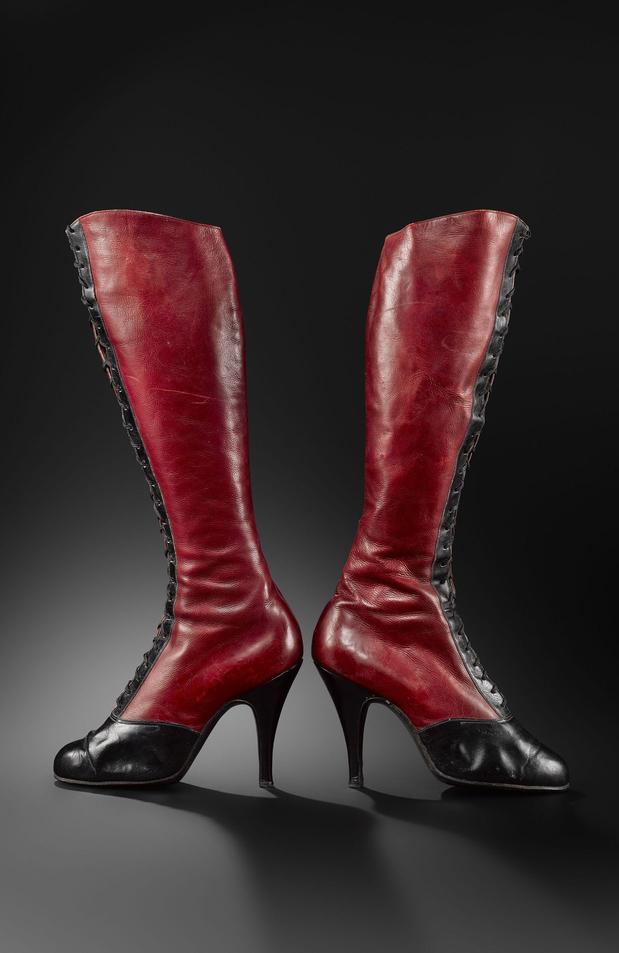The shoe, a story of suffering and constraint<
"Walking and walking", an exhibition on the history of footwear at the Musée des Arts Décoratifs in Paris, explores the relationship between the body and the shoe, this "most persistent example of the imposition by mode of an idealized form on the natural anatomy".
The inspiration comes from the shoe worn by Marie-Antoinette in 1792, which corresponds to size 33, fashion historian and curator of the exhibition Denis Bruna told AFP. Other models of shoes of the aristocrats and great bourgeois of the 18th and 19th centuries are hardly larger.
"How could we fit adult feet into such small shoes?" he wondered.
It's that "the upper classes did not walk. They had to stay confined to the house. Confronting the puddles, the mud, the filth was reserved for the common people with their big feet", he explains.
An 1802 podiatry textbook advised 'wrapping the toes with ligatures' to have pretty feet and the generation well born at the beginning of the 20th century had thin feet from having worn in childhood shoes one or two sizes down.
Erotic object
The cult of the small foot comes from China where since the 11th century the toes were folded under the arch of a girl from 5 years old.

"Sometimes we did not hesitate to break the bones with a metal rod to accentuate the curvature. The ideal was to reach a size 26 maximum in adulthood and a foot in the shape of a button. lotus", says Denis Bruna.
"Girls praised the merit of their small foot for a good marriage" and this shod lotus, even during sexual intercourse as a painting shows, was "an erotic object much sought after by men".
This theme is taken up again in the section devoted to fetishism, where you can see very high boots with very tight laces evoking the fantasy of clients in brothels by half-opening the black curtains.
In 2007, the filmmaker David Lynch photographed dancers from the Parisian cabaret Crazy Horse wearing Louboutin shoes with excessive heels, some impossible to wear, in a fetishist universe.
Heels of 12
It was not until the second half of the 20th century that comfort appeared.
At the last Dior haute couture show in July, the heel was almost banned by Italian feminist designer Maria Grazia Chiuri, who imagined the shoes consisting of just a sole glued to the stockings.
For the designer, from an anthropological point of view, the heel is a "contemporary evolution of the Chinese tradition of lotus feet".
A tunic dress was embroidered with "Are clothes modern?" (Are clothes modern?), title of the famous book by architect Bernard Rudofsky which inspired the collection.
In this 1947 work, the architect pointed out that we model our feet to make them conform to a fixed ideal.
To feel it, the exhibition invites the visitor to slip their feet into shoes with vertiginous platforms or with enormous pointed toes and try to walk around, leaning on bars.
Another space offers a selection of cult cinema scenes with, among others, the legendary walks of Marilyn Monroe or Jeanne Moreau perched on high heels.
"Today, for twenty years with sneakers, it is comfort that takes precedence in the choice of shoe", underlines Denis Bruna, but cultural imperatives will still weigh on our choices.
"There are girls who ask me why we can't find 12" cm heels anymore, confides to AFP Pierre Hardy, designer of luxury shoes for women and one of the first to make chic sneakers for men.
"For me, no one wants to walk in a 12 heel anymore... but some girls love it, which seems to me absolutely paradoxical, even miraculous".
READ ALSO.
Strong and graceful: the Dior women, these modern caryatids
In Thailand, the miraculous return of sacred lotuses
Zegna and Plein kick off Milan Fashion Week in a big way
Paris loses its Museum of Eroticism: its naughty collections at auction
Robert Clergerie, the shoemaker who couldn't slip


 Tags:
Tags: Prev
Prev







